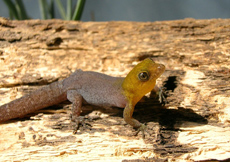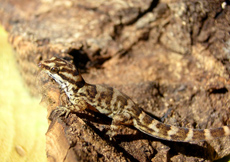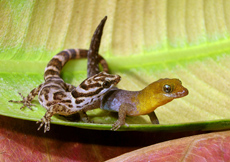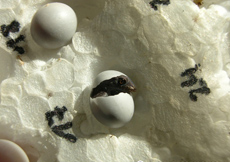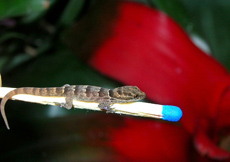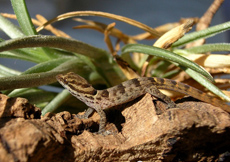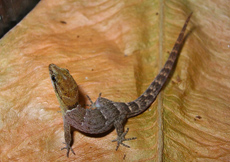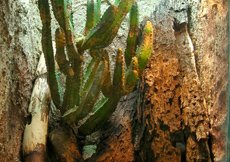Gonatodes antillensis
(LIDTH DE JEUDE, 1887)
Distribution:
Offshore Islands, North of Venezuela (Orchilla, Las Aves, Los Roques), Bonaire, Curacao and Aruba.
Description:
Gonatodes antillensis has a SVL between 33-38 millimeters (BENNETT & GORMAN, 1979). While it's total length is about 70 millimeters, making it one of the smallest species of the genus Gonatodes. Both males and females do not differ in size, however as with all other species of Gonatodes, sexual dimorphism is strong. The males are light gray in color and their head is bright yellow. Their tail, towards the tip, is a darker gray. This Gonatodes species offers a true feast for your eyes. The females have a light beige, almost white base color, with dark-brown washed-out bands across their back. On their neck is a thin white band. Their head has two black U-shaped patterns, which pass through the eyes, uniting at their nose. The tail has richly contrasted bands. Juveniles have the same color and pattern as the females, however, at about 3 months, they lose this coloration, provided they are male offspring.
Their slit shaped pupils classify them as nocturnal. Like all other members of the genus Gonatodes, the toes of Gonatodes antillensis, are covered with claws, thus they cannot climb on glass or other smooth surfaces.
Habitat:
The climate of the South American islands is very different from the other Caribbean islands. It is hot and dry, with temperatures rising on average daily in summer to almost 34°C (93.2°F). In winter, temperatures rise to 30°C (86°F). Nightly, temperatures throughout the year are about 25°C (77°F). The summer months have less rainfall, during the winter months the rainfall increases to an average of 60-70mm, between October and Janurary (Source: Climate chart Oranjestad, Aruba).
Gonatodes antillensis inhabits dry vegetation; in leaf litter or between and under stones (BENNETT & GORMAN, 1979). They may even be found in columns of trees, or the crevices of house walls. In nature, their activity period begins with twilight and ends with sunrise. During the day their body temperature reaches 34.5°C (94.1°F), which concludes temperatures in the microhabitat are warm. At night, their body temperature drops to 27°C (80.6°F). They feed mainly on insect larvae. For Bonaire, the population density is very high, it is indicated that 4,200 individuals can be found per hectare (BENNETT & GORMAN, 1979).
Husbandry and Breeding:
Due to their small adult size, Gonatodes antillensis can be housed problem free in a 30 centimeter cube. Group housing is not possible, therefore, they should only be kept as a pair or individually. Based off of habitat information, the terrarium should be designed as a drier terrarium. The substrate should be a thick layer of sand. The rear and sidewalls should mimic a rocky surface, which is easily achieved by using tile adhesive, or something similar. Pieces of bark, piled up stones (be sure to secure these!) or slate should be placed against the terrarium walls, to offer the animals a place to hide or sit. Natural vegetation, such as drought loving plants like Euphorbia, cacti or Tilliandsia, help create the perfect microhabitat. A small bowl of water, as well as a small bowl of crushed up cuttlefish bone or eggshells complete the terrarium design. Illumination of the terrarium may be provided using T5 or T8 lamps rated for daylight color. Since daytime temperatures may safely reach between 32-34°C (89.6-93.2°F), the use of a small watt halogen puck light can be used. Alternatively the use of a heat mat on the rear or side walls, to help reach the desired temperatures are also possible. To help maintain a humidity between 40-50% the terrarium should be misted lightly every 2-3 days. To help simulate a natural seasonal rhythm, the illumination period should be for 12 hours daily in the summer months and reduced to 9 hours in winter. In winter, the temperature should be reduced by 5 degrees. During the winter months, the terrarium should be misted slightly more often, to help simulate a light rainy season. Adult Gonatodes antillensis, should be feed twice weekly with a highly varied diet in an approriate size for the animals. Suitable feeders are small crickets, bean beetles, Drosophila, pea aphids, woodlice and firebrats. All food should be dusted every second feeding with the approriate supplements. After a simulated rainy season, the pair will proceed to breed in spring. Three weeks after mating the female will lay a single egg in a dry sheltered location. To offer the female a place to lay her eggs, small tubes of Japanese knotweed (Reynoutria japonica) or similar should be placed at different heights against the rear and side walls. It is important to note that whatever type of tubes you select, that the insides of the tubes should not be too smooth. For better control over the eggs they should be moved to an incubator where the humidity is a bit more elevated. The eggs should be kept on a dry surface and incubated between 28-30°C (82.4-86°F). After about 75-100 days, the young emerge with a total length of 3.4-3.6 centimeters. The young can be reared in small converted household containers. Like the adults, the young should be provided a highly varied diet. The food of the young should be dusted at each feeding with the approriate supplements. Communial housing of the young is possible with other Gonatodes species or members of the genus Sphaerodactylus. Young males color up very early, at about 3 months old their yellow head is already visible. At this point you should raise the males separately from one another. At one year of age, the offspring are fully grown and ready for future breeding.
Gonatodes antillensis is an exceptional representative of the genus Gonatodes. Although they are considered nocturnal, I can often see my animals sitting out in the open most of the day and they can often be observed without disturbing them. Even if I open the terrarium they do not frantically try and escape from me, but still sit looking curiously at me. The males show their coloration not only during the breeding season, but throughout the year. The females are also colored quite nicely, year round. This species is still quite rare in Europe, but because of their remarkable behavior, the number of breeders is increasing quite steadily.
Literature:
- Bennett, A. F. & Gorman, G. C. (1979): Population Density and Energetics of Lizards on a Tropical Island. Oecologia (Berl.) 42, 339-358.
